
2 hours ago
Lucy Lawless Confirms Lesbian Subtext in ‘Xena: Warrior Princess’: “The Writers Knew Exactly What They Were Doing from the Start”
READ TIME: 2 MIN.
In a revealing conversation with Entertainment Weekly, Lucy Lawless, who portrayed the titular character in ‘Xena: Warrior Princess,’ directly addressed the long-standing debate over the lesbian undertones in the series. “The writers knew exactly what they were doing from the start,” Lawless stated, confirming that the romantic and emotional depth between Xena and her companion Gabrielle was no accident but an intentional part of the show’s DNA .
Since its debut in 1995, ‘Xena: Warrior Princess’ has been recognized not only for its campy action and mythological storytelling but also for its groundbreaking depiction of female relationships. The bond between Xena and Gabrielle, played by Renee O’Connor, drew devoted LGBTQ+ viewership, especially among lesbian audiences who saw in their connection a rare reflection of queer love on mainstream television .
For years, the nature of Xena and Gabrielle’s relationship was described as “subtext”—an undercurrent of romantic possibility never explicitly stated but clearly present. Fans and critics alike dissected episodes for coded gestures, lingering glances, and moments of intimacy, leading to the show’s status as a cult classic and a touchstone in LGBTQ+ media history .
Lawless’s confirmation adds a new dimension to the show’s legacy. “It’s very clever,” she remarked, reflecting on how the writers balanced suggestiveness with deniability, allowing viewers to interpret the relationship through their own lens . This creative ambiguity was partly a response to the television climate of the 1990s, when openly LGBTQ+ characters and storylines were rare and often met with resistance from networks and advertisers .
Liz Friedman, an out lesbian producer and writer for the series, has previously spoken about the constraints of the era. “Certainly in a single-lead action show we’re not ready for an openly gay heroine yet. Well, I think we’re ready for it. I don’t think the networks are going to let us do it,” Friedman told AfterEllen, reflecting the industry’s reluctance to embrace full representation at the time .
Despite these limitations, the resonance of Xena and Gabrielle’s relationship was profound. The series became a haven for LGBTQ+ viewers hungry for positive, multidimensional representation. Renee O’Connor recalled in a 1997 People interview that as more lesbians started watching, the show leaned into the chemistry between the two leads, acknowledging the growing queer fandom .
The romantic undertones, though never fully realized on screen, were seen by many as a code that allowed queer audiences to see themselves reflected in heroic roles. The nuanced portrayal was especially significant at a time when most LGBTQ+ characters on TV were relegated to side plots or stereotypes .
Today, ‘Xena: Warrior Princess’ is widely credited with opening doors for more explicit LGBTQ+ representation in genre television. Shows like ‘The L Word,’ ‘Batwoman,’ and ‘Wynonna Earp’ have built on the foundation laid by Xena, offering queer protagonists and love stories front and center. However, as Lawless’s recent remarks highlight, the careful subtext of Xena and Gabrielle’s relationship remains a masterclass in queer storytelling under constraint .
For many fans, the acknowledgement from Lawless is an overdue validation of what they knew all along: that the love between Xena and Gabrielle was written not just between the lines, but into the very heart of the show.






